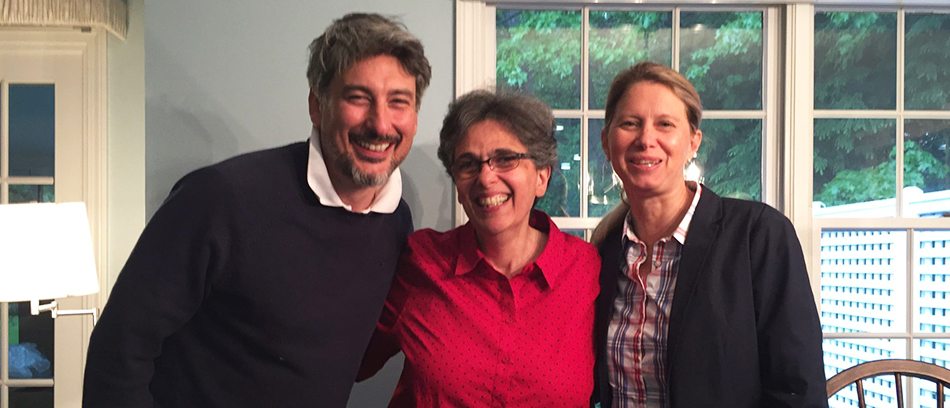Reading time: 7 min
by Alice Alessandri e Alberto Aleo
We arrived in Newburyport near Boston on a late spring day to interview our friend and mentor Mary Gentile. It is always a joy to meet up with her as we are bound to Mary by esteem, friendship and deep gratitude. She was the first to believe in the project for our book, which was first published in Italy with the title “La Vendita Etica” and later came out in the US as “Sales Ethics”. Mary is the creator of an innovative method called “Giving Voice to Values” that helps people and businesses to act according to their values, thus achieving better results. The first aim of our interview is to illustrate how this innovative approach has revolutionized the way people are taught about business ethics. But we also wish to describe the courage and passion of a person who has remained fresh and approachable, open to dialogue and always ready to help others, while also collaborating with universities like Harvard, Babson and Virginia and becoming a “star” in her area of specialization, with articles published on the world’s most prestigious journals.

Let’s start with the description of “Giving Voice to Values”, the book that describes in detail the techniques used in this approach. Here, in Mary Gentile’s own words, is how the method was born …
When I started my academic career in the world of Business Ethics, I realized that something was wrong in the approach to teaching: the participants showed little engagement in the courses because they considered them to be insufficiently practical. At the time, any course in ethics designed for economics students and managers taught them how to distinguish what was right from what was wrong in certain situations. There were very few tips that could actually be put into practice, and almost no instructions on how to actively use ethics to improve performance, and not just how to react when faced with improper behavior.
I wanted people to consider business ethics as a useful tool for success and not a drawback, but it wasn’t easy to change a model that become established since the 1970s.
So, I started building a strategy that would make my ideas acceptable by involving colleagues, entrepreneurs, managers and everyone who believed this change was needed. I actually gave voice to my own values and my ideas! The same techniques that I used to achieve these results now form the basis for the Giving Voice to Values method.
But how does the GVV method differ in practice from a traditional approach?
Our method deals with behavior and not abstract theories about corporate morality. GVV does not want to judge people and their choices or convince them what is right, but to help them be attentive to their inner selves.
Many of our non-ethical behaviors do not stem from uncertainty about whether a certain act is morally right or not, but the idea that being ethical is either ineffective or impossible. In most cases, people know what they should do but are afraid of the consequences of doing the right thing (missed opportunities, reduced turnover, anger from their superiors, exploitation by others, weakness). We want to provide techniques that can help everyone to act efficiently while following their own heart. We stimulate the participants’ creativity by inviting them to plan an action in line with their beliefs, by evaluating and managing its outcomes so they can achieve their goals. We want positive cases to grow within organizations and thus demonstrate how acting coherently with what we are, and with our own values, can lead to success, because we are certain that changing individuals’ behavior will change an organization’s culture.
What’s the reaction of the market and the multinationals to this idea of granting “power” to individuals?
Modern markets are characterized by a considerable democratization of communication tools. One of the consequences is that it’s now difficult to cover up scandals and improper behavior. Some of the organizations in which I’ve started introducing the Giving Voice to Values method (such as Unilever ed.) have already realized that transparency and coherency are the basis for success. More and more people are looking at companies as a way of achieving their idea of happiness. It is clear that both as employers and as producers of goods and services, multinationals nowadays often have a greater impact than individual States on ensuring that we lead a full and rewarding life. And what’s better than helping people to act, work and consume in a way consistent with their values? That is why GVV is now growing ever more popular in the business world as well as in academia.
Can you give us some examples on how to apply your method?
GVV applies to so many areas that it’s difficult to pick out all the valid techniques contained in the book. We have dealt with medicine, law, the army and, of course, sales in the work done together on the book Sales Ethics (which is part of the Giving Voice to Values collection directed by Mary). When I start a consult, one of the first things I suggest you do is think about your values and your own idea of values-driven success, without censoring your thoughts or worrying about whether your ideas are possible. Then ask yourself, “What should I do to accomplish my idea? How could I encourage others to accept it? What kind of help do I need?” To find the answers I help people develop their own, and others’, listening skills. .
We can only plan effective communication after we’ve understood different points of view. The time for a mechanical and unique approach to strategy and success is over: you have to adapt your actions to your values and broaden your vision, taking even the most intangible aspects into consideration, such as emotions and relationships over time.
Your last name shows your Italian origins: how important were they in your success and how closely are you now linked to Italy?
I would not be here talking about “Giving Voice to Values” if I had not been born into the family I had! The environment I grew up in was marked by precise values, not abstract concepts, that guided our choices every day. I would debate these values in long conversations with my parents, perhaps at the dinner table. I find this inspired practicality to be one of the most interesting aspects of Italian culture: one of the reasons why, according to a recent study by Harvard University, many of my fellow Americans state that if they were to select an alternative nationality they’d choose Italian. Another thing I love about your country is the constant quest for quality in life and relationships, which can also help us make the most correct professional decisions when properly guided. The micro-businesses that are a mainstay of Italy’s industrial fabric are also making a comeback in the US, because they give form to the idea that if you have strong values and can voice them and put them into practice in the workplace, you will release much greater power than you might have expected and you will achieve the success you are looking for.
It is time to round off the interview and continue our chat with Mary in private. We go to dinner at one of the restaurants in this quaint little village on the Massachusetts coast, once home to pirates and smugglers, now an attractive and elegant resort populated by intellectuals and professionals. Mary’s companion joins us, a psychologist with whom our friend shares not only her life, but many professional interests too. Seeing them relaxing together as they casually switch between discussions about work and life choices, reminds us that one of the secrets of happiness is just that: being yourself whatever the context.
– – –
As Mary reminds us:
“I don’t want to do things unless I am committed or they make me happy and content. I have received professional offers that would bring more money or greater prestige but I did not love them. GVV is hard work, often stressful, and sometimes I feel exhausted, but it is also a gift that brings me great joy. The techniques I teach in the classroom are the result of my personal quest for happiness: I too wanted to find a way to give voice to my values!”
By freeing herself, finding her own path, Mary has allowed many others to do the same, including the two of us!!!
– – –

For more information on Mary Gentile and her innovative Giving Voice to Values method, you can visit the website www.givingvoicetovalues.org or take part in one of her on-line courses.
| partem claram semper aspice |
The photos used - where not owned by the editorial team or our guests - are purchased on Adobe Stock and IStockPhoto or downloaded from platforms such as UnSplash or Pexels.
Did you like this post and want to learn more about the topics?
Passodue research on issues related to sales, marketing, ethics and the centrality of human beings within the market logic, officially started in 2012. The results derived from our work are described in the publications and in the books you can find in this section.






Comments (0)